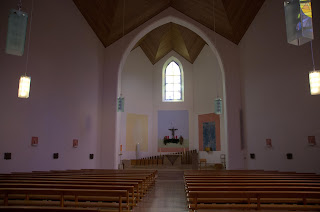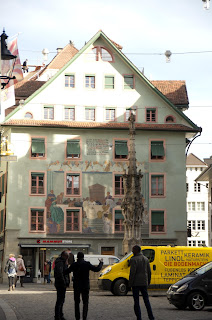While we stayed in Lucerne, we visited the tourist
information office – always a good idea when entering a new town. They provided
a map and booklet for Lucerne and recommended that we purchase a Tell-Pass
which would pay for all our trips on the trains, boats, buses, and chairlifts
in the area for as many days as we chose. At 100 Swiss francs apiece, it was
expensive, but we used so much that our trips ended up about half price. We
visited two different towns by train, rode the chair lift up to Mt. Pilatus, and
took a three-hour tour of Lake Lucerne.
Our first visit was to Einseideln where we visited a
beautiful still-active Benedictine monastery built in the early 18th
century and meandered through our first Christmas market. On the train ride to Einseideln,
we were treated to splendid views of lakeside villages and farms and passed a
ski jump used for Olympic training.
The monastery had its beginnings in the story of Meinrad, a
Benedictine monk who desired the life of a hermit in the forest. He was killed
for his non-existent treasure 861. The killers were followed back to Zurich by
his two tame ravens. They were identified and hanged for the crime. In 934, the
‘recluses of the forest’ were convinced to form a Benedictine community out of
which grew the monastery. Today, the monastery belies its rustic origins with
its stunning interior where pictures are not allowed.
The walk from the train to the monastery heads right though
the Christmas market lining the street so we got to visit it twice and were enticed
to make a few purchases.
 |
| Catholic and Protestant Churches sharing space |
The next day we visited Interlaken, two hours by train in
the opposite direction. The ride is even more beautiful even on a cloudy day. Interlaken
is a small tourist town made famous as an international meeting place before
World War I. it is also the center for a wide variety of summer and winter
mountain activities. The nearby Jungfrau and Eiger mountains draw mountain
climbers world wide. Our big disappointment was that so much of this activity
is oriented towards the summer. The funicular
next to the train station was closed for the winter, much to our surprise. We did
see a number of hang gliders landing in the field in the center of town. We also
visited the most starkly decorated Catholic church we would see anywhere. We were
surprised to discover that it is a cathedral.
 |
| A very small dog park for only one purpose |
 |
| One of the many hotels in Interlaken |
We wandered through town, had a nice fondue for lunch,
purchased a new winter coat for Linda who was sadly underdressed for the cold
weather and enjoyed the return train ride to Lucerne.
The next day we ascended Mt. Pilatus, another mountain for
summer activities. The amazing views from the mountaintop were worth the trip,
but we were surprised to find only one short walk carved into the mountainside
to protect it from the snow available for ‘hiking’. We were entertained by two
Alphorns which provided a fitting musical accompaniment to the views. We were
again disappointed that the funicular we hoped to ride down to the lake for a
boat ride back to town was also closed for the winter .
Upon our return to town we bought sandwiches for a quick
lunch and hopped on one of the boats for a three-hour cruise of the lake. The boat
was really a people ferry making a round trip. Locals and tourists joined us
for parts of the ride. This was the most beautiful of our three days in Lucerne
so we had great views of the towns and mountains and we circumnavigated the
lake.
Someday we will return to this beautiful spot during the
spring or fall when we can enjoy more of the mountain activities.





































